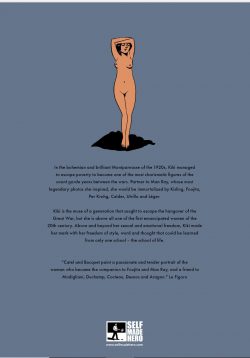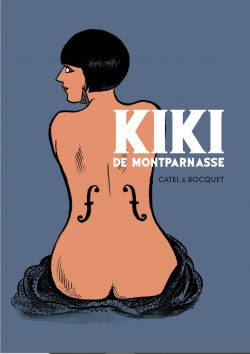

By Catel & Bocquet, translated by Nora Mahoney (SelfMadeHero)
ISBN: 978-1-90683-825-6 (TPB/Digital edition)
Like all art students in the 1970s and early 1980s I fell in love with Surrealism and Dada and even had a copy of Man Ray’s print of the naked chick mimicking a cello on a wall for a while. The model was his greatest muse – Kiki of Montparnasse.
I revelled in how the image was a clever juxtaposition of idea and image and never gave much thought to the actual woman in the picture. That was a huge mistake, thankfully rectified here in this supremely moving account of the life of an indomitable soul who encapsulated and epitomised an extraordinary era…
Please take heed: this book contains both nudity and nakedness in large amounts. Don’t read it if such drawings might affect you in unwholesome ways…
Alice Ernestine Prin (2nd October 1901 – 29th April 1953) was born in Châtillon-sur-Seine, Côte-d’Or. She was a child of shame and poverty, wilful and a bit wild: surviving life amongst the lowest classes. She grew up in northern France in a region of agriculture, heavy industry and especially winemaking: raised by a grandmother and often-visiting godfather. Alice had her first drink and danced for inn patrons at ten. It kept happening until her already-disgraced mother abruptly returned in 1913 before the girl was packed off to Paris to learn a trade.
That’s when her life really began.
That life is traced from cradle to grave in a rapid-fire procession of black-&-white vignettes, that first focuses on her childhood and brushes with education, whilst concentrating on her happy but unconventional family life and relationships.
Already wise beyond her years in the things that mattered, Alice clashed with a number of employers in crappy jobs – such as bakery assistant or domestic servant – and dreamed of love and adventure, independence and fame…
She reached her majority just as Europe was changed forever by “The War to End All Wars”, and was on hand and at the forefront as the entire continent – but especially France – survived the communal mass PTSD dubbed the Années Folles or “Crazy Years”. An era of wild excess, free thought and fresh art and literary exploration, much of it triggered by shock, disenchantment and crumbling social order: the reaction of a generation who thought they were rebuilding themselves and society, but were in fact only gearing up to do it all over again…
With wounded soldiers everywhere and employment scarce, in 1916 Alice agreed to model for a sculptor buying bread: a scandalous job she at first concealed from her mother. When the outraged matron learned the truth, she disowned her daughter…
Two years later, she was an occasional singer and dancer and a paid escort too, but poverty was still biting too deep. Modelling was not a highly paid profession and most artists were just as poor as their subjects, but life took an upward turn after she was introduced to a promising prospect named Amedeo Modigliani…
He showed her to Utrillo, and thus to Mendjinsky and…
By 1920 she had remade herself and was known only as “KIKI”: bold, brassy, shamelessly confidant and utterly in command of the close community and artistic colony of defiant non-comformists of Montparnasse. Her star was on the rise and everyone one wanted to capture her in their own way. Her intimate associations would include Sanyu, Chaïm Sountine, Jean Cocteau, Julie Mandel, Constant Detré, Francis Picabia, Arno Breker, Alexander Calder, Per Krogh, Hermine David, Pablo Gargallo, Tono Salazar, John Glassco, Moïse Kisling and so many others who would reshape the creative world.
In 1921 she met her most devoted acolyte in Tsuguharu Foujita and the man who would make her immortal: American photographer Man Ray (Emmanuel Radnitzky). She had also begun selling her own paintings, starring in numerous surrealist and Dadaist films and even performed in Ferdinand Leger’s Ballet mécanique in 1923…
Somehow, however, fame never quite equated to fortune, even though in June 1924 Man Ray’s image Le Violon d-Ingres (Ingre’s Violin) was first published in Surrealist magazine Littérature, with her astounding energy, creativity and catalogue of innovations and successes acting as a mere spine to form an impression of the woman whose guiding motto was always “be natural”. In May 2022, an original print of the image sold at auction for $412,400,000.
In love with fame and too forgiving with her lovers, KIKI flowered through those wild days luxuriating in independence and glamour, approval and rejection, notoriety, renown, and – outside her world and the art world – utter anonymity. Always, though, she lived it on her own terms…
How that all worked out comprises the majority of this stunningly inviting and compellingly absorbing cartoon biography: an award-winning tale that is the very picture of a rags-to-“riches”-to-rags melodrama and one as charming and uncompromising as any carefully constructed work of fiction.
This sublimely moving episodic dramatised narrative is a tasty wonder in bite-sized pieces and the first multi award-winning collaboration between graphic novelist Catel Muller (Ainsi soit Benoîte Groult, Adieu Kharkov, Lucie s’en soucie, Le Sang des Valentines, Joséphine Baker, Olympe de Gouges, Alice Guy) and crime novelist, screenwriter, biographer/comics writer José-Louis Bocquet (Sur la ligne blanche, Mémoires de l’espion, Panzer Panik, Joséphine Baker, Olympe de Gouges, Anton Six, Alice Guy).
The result is an exceptionally entertaining, engaging and informative account which is supplemented by a vast supporting structure of extras, beginning with a heavily illustrated and highly informative ‘Chronology’ tracing in minute detail all the pivotal events in KIKI’s short sharp life, which never changed the world but certain embraced and enjoyed it…
That’s further augmented by ‘Biographical Notes’ offering scholarly character portraits in prose and sketch form: all key historical figures impacting the model’s life, including Chaïm Sountine, Amedeo Modigliani, Moïse Kisling, Tsuguharu Foujita, Henri-Pierre Roché, Man Ray, Marie Vassilieff, Pablo Picasso, Tristan Tzara, Robert Desnos, André Breton, Marcel Duchamp, Trieze, Ivan Mosjoukine, Jean Cocteau, Henri Broca, Lee Miller, Ernest Hemingway, Jamblan, and André Larocque, and a Filmography of the movies researchers have since confirmed and acknowledged, and a colossal ‘Bibliography’ of books about her.
© 2011 SelfMadeHero. Illustrated by Catel. Written by José-Louis Bocquet. All rights reserved. Digital edition © May 2016.
